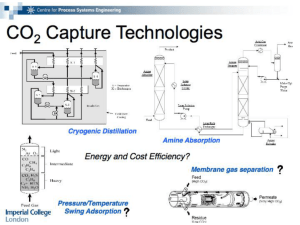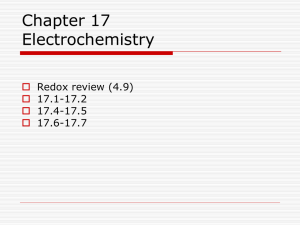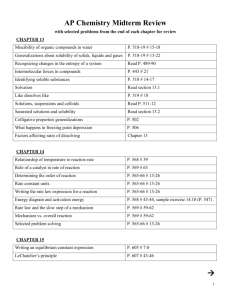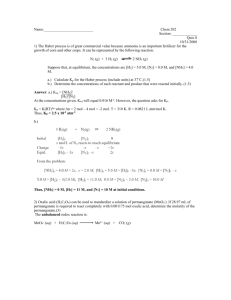Wordfile
advertisement
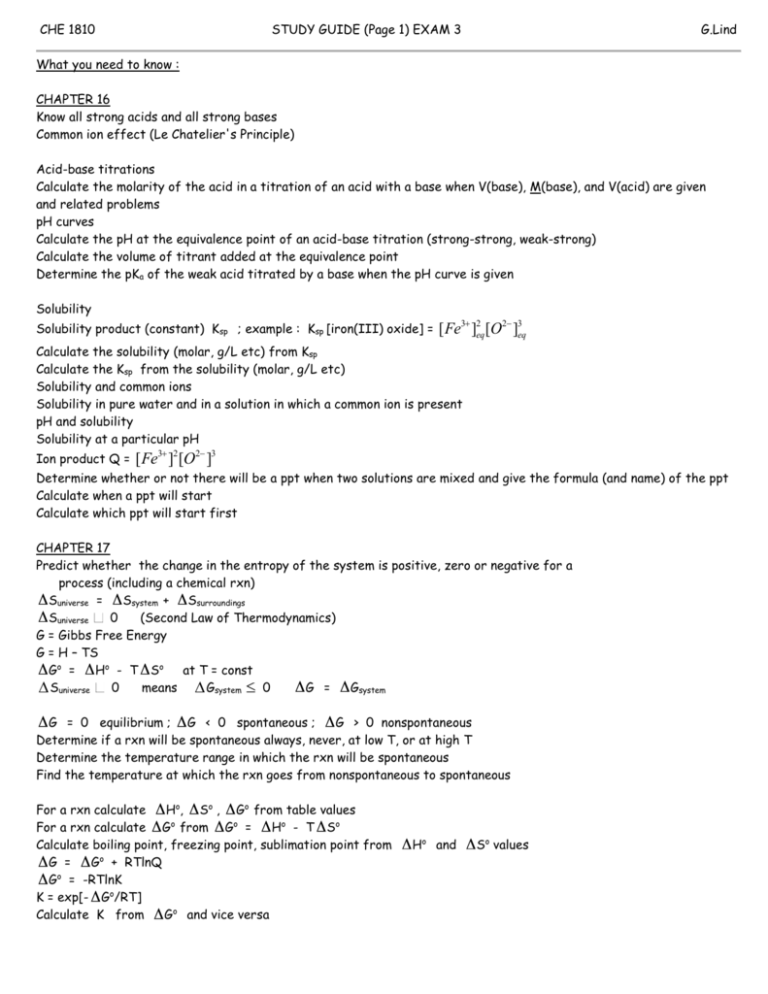
CHE 1810 STUDY GUIDE (Page 1) EXAM 3 G.Lind What you need to know : CHAPTER 16 Know all strong acids and all strong bases Common ion effect (Le Chatelier's Principle) Acid-base titrations Calculate the molarity of the acid in a titration of an acid with a base when V(base), M(base), and V(acid) are given and related problems pH curves Calculate the pH at the equivalence point of an acid-base titration (strong-strong, weak-strong) Calculate the volume of titrant added at the equivalence point Determine the pKa of the weak acid titrated by a base when the pH curve is given Solubility Solubility product (constant) Ksp ; example : Ksp [iron(III) oxide] = 2 [Fe3+ ]eq [O2- ]3eq Calculate the solubility (molar, g/L etc) from Ksp Calculate the Ksp from the solubility (molar, g/L etc) Solubility and common ions Solubility in pure water and in a solution in which a common ion is present pH and solubility Solubility at a particular pH Ion product Q = [Fe3+ ]2 [O2- ]3 Determine whether or not there will be a ppt when two solutions are mixed and give the formula (and name) of the ppt Calculate when a ppt will start Calculate which ppt will start first CHAPTER 17 Predict whether the change in the entropy of the system is positive, zero or negative for a process (including a chemical rxn) Suniverse = Ssystem + Ssurroundings Suniverse ³ 0 (Second Law of Thermodynamics) G = Gibbs Free Energy G = H – TS Go = Ho - T S o at T = const S 0 means G = Gsystem D universe ³ D Gsystem £ 0 G = 0 equilibrium ; G < 0 spontaneous ; G > 0 nonspontaneous Determine if a rxn will be spontaneous always, never, at low T, or at high T Determine the temperature range in which the rxn will be spontaneous Find the temperature at which the rxn goes from nonspontaneous to spontaneous For a rxn calculate Ho, So , Go from table values For a rxn calculate Go from Go = Ho - T S o Calculate boiling point, freezing point, sublimation point from G = Go + RTlnQ Go = -RTlnK K = exp[- Go/RT] Calculate K from Go and vice versa Ho and So values CHE 1810 STUDY GUIDE (Page 2) EXAM 3 CHAPTER 18 Know how to name inorganic compounds (ionic, covalent), ions, and acids Determine the oxidation number (oxidation state) of each element in a compound/ion Determine the species oxidized, reduced, oxidizing agent, reducing agent Determine whether a rxn is a redox rxn or not Balance a redox rxn in acidic/basic solution Half reactions, overall rxn including electrons Galvanic Cell Construct a galvanic cell from two electrodes (half reactions) Calculate the standard cell emf Calculate the cell emf (given concentrations and pressures of reactants and products) using the Nernst Equation Write the cell diagram of a galvanic cell Make a sketch of a galvanic cell Find the anode, the cathode, the oxidation, the reduction Find out which way a redox reaction is spontaneous Find out if X can be oxidized by Y There will be calculations – bring your scientific calculator Please turn your cell phone OFF Show all your calculations Show your calculations with units Report your answers with correct units and correct sig. fig. No units = wrong units Partial credit only when all work is shown with units No credit for a bare answer Because of time constraints I cannot guarantee that all subjects listed above will be on the exam One or more end of chapter problems may be on the exam One or more PE problems may be on the exam There may be some multiple choice problems (like the ones on the final ACS exam) on the exam Cheat Sheet : One letter size sheet (front and back). Only handwritten entries. No copies from a book taped or stapled No end of chapter problems with solutions on the cheat sheet No practice problems on the cheat sheet No solutions to practice problems on the cheat sheet Your name must be printed on the cheat sheet. The cheat sheet must be turned in with the exam G.Lind
